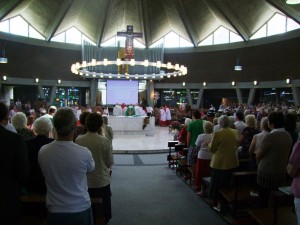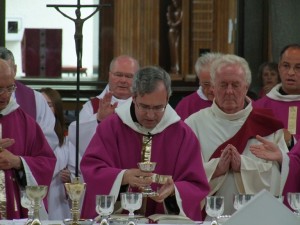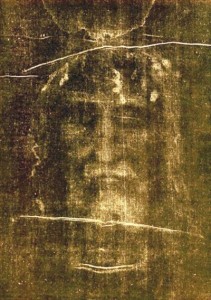Easter tide, the resurrection of Jesus, and the Eucharist are closely linked, and this threesome achieves its ultimate culmination in heaven. The Eucharistic Prayer of the Mass is a fascinating Prayer. It is intended to be our contemplation of heaven; more than that, it is our participation in the life of heaven. Every Mass we celebrate links heaven and earth, and if for some, it may be thought rather dull, repetitive and boring, what could – needs to change, essentially – is what that bored parishioner feels in heart and mind. It is possible to enter the reality of heaven when anyone, lay person or ordained priest, is ‘celebrating’ Mass. We can engage in our heart and mind, linking our felt experience of life, of prayer, or forgiveness and salvation, to what we hear. The good and bad things of life, all that is part of the heavenly journey for each one of us and all of our experience is linked for each person with the presence of God.
My limited experience of the Orthodox Liturgy has led me to realise that they are excellent at making a celebration in Church feel like a moment of heaven. The emotive and repetitive singing, the incense (used quite a lot), the appearances (and disappearances) of the priest, the many candles burning, the choir responding, all of these different factors contribute to the experience; their services are not so functional, and matter-of-fact, as our liturgy. For me, the most memorable event comes from an occasion 40 years ago, when a friend, Fr Symeon Piers, celebrated the Orthodox liturgy in the chapel contained in a caravan, just outside the hostel for Orthodox boys, attached to Ampleforth College. I still have a vivid memory of the sense of ‘the sacred’. But, be warned: their Sunday Mass is not three quarters of an hour long – it is sometimes three hours long!
 |
It is possible to enter the reality of heaven when anyone, lay person or ordained priest, is ‘celebrating’ Mass.
I find it helpful to realise, and to try and imagine, at Mass, what heaven is like. I see it as a combination of many things – a kind of vortex of dynamic fire, a wonderful ‘court’ where all are focussed on glorifying the One who sits on the throne, at the heart of it all, a huge ‘Ocean of Love’, a continuous and changing relationship with others who are there, all united in Love who is God, within the vortex of the dynamic fire; in that vortex there is always more to be understood, enjoyed and shared in. Each person may well elaborate their own ‘pictures’, possibly ‘images’, of just how the scene is portrayed. My image, or picture, of heaven is influenced by the well documented and famous experience of Paradise that was given to Chiara Lubich in 1949. (If you want to read more about this, please go to the website of the Parish, to documents and albums, scroll down to documents and you will find an English translation of a talk given by Chiara Lubich, herself, on 30 June 1961 in Switzerland).
Andres Rublev’s Holy Trinity
In heaven, God the Father is the focus of the dynamic joy of all, because all comes from Him, and returns to Him. This is made possible by the Word of God – through whom all things were made and who is the risen Jesus Christ – and in the power of the Holy Spirit, through whom we gain the graces that enable us to be one with Jesus, whilst on the journey to the Father for his glory.
The Preface that begins the Eucharistic Prayer is the ‘give away’:
‘It is truly right and just, our duty and our salvation, always and everywhere to give you thanks, Lord, holy Father, almighty and eternal God through Christ our Lord…’
This is followed by the ‘Holy, Holy, Holy’, which proclaims the glory of God the Father, and the blessedness of the ‘One Who Comes In The Name Of The Lord’. Here, right at the start, all is focussed on the holiness, the glory of God the Father, and our thanksgiving to be at one with Him, united with Him – inserted into Him – and His Love.
Focussing on the second Eucharistic prayer, the shortest of them all, it begins in relationship to God the Father.
‘You are indeed Holy, O Lord, the fount of all holiness…’
 |
Abbot Cuthbert Madden presiding at the Funeral Mass
of Bishop Ambrose Griffiths in St Mary’s Leyland
Here, we implore the Holy Spirit to use his power to make present in the bread and wine, the person of Jesus Christ. We enter heaven only through the experience of the Death and Resurrection of Jesus; no wonder that we have the account of the institution of the Eucharist in each Eucharistic prayer. The Eucharist makes present, for us, this once and for all, redemptive event of Calvary and the Resurrection, here in our own time. This event, and all the graces that flow from it, is what brings all the inhabitants of heaven, to their home there. It is central to the joy, and thanksgiving, of heaven; it is pure, self-giving Love, that each lives to the fullness of the differing capacities of everyone present.
 |
Image of Christ on the Holy Shroud
Within the Eucharistic prayer, there are prayers of request, as it were, realistically introducing the idea that we, on earth, need the help of God, the Holy Spirit, to be worthy of Paradise:
‘Humbly we pray that, partaking of the Body and Blood of Christ, we may be gathered into one by the Holy Spirit’.
Then, after more prayers for the living and the dead, the prayer ends with the wonderful Doxology to the Holy Trinity, proclaiming the utter majesty, goodness and glory of God; the prayer ends as it begins:
‘Through him, and with him, and in him, O God, almighty Father, in the unity of the Holy Spirit, all glory and honour is yours for ever and ever’.
There follows the ‘Great’ AMEN, and one can readily understand just why the congregation is asked to put heart and soul into that ‘massive’ response.
Potentially, in the Mass, everyone present has simply brought their poor and weak selves into Paradise; there, and together, all are united in the One Body of Christ; all thus share a moment of heaven.
Fr. Jonathan
